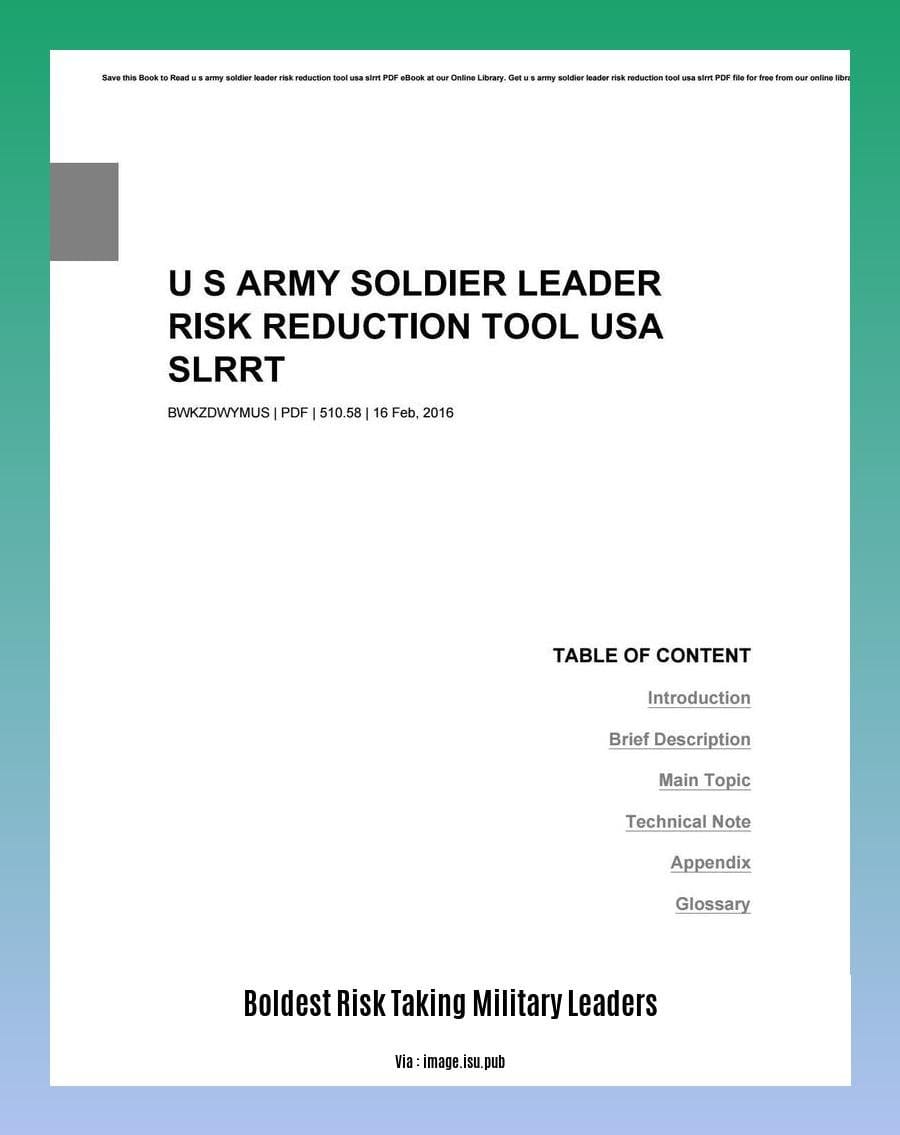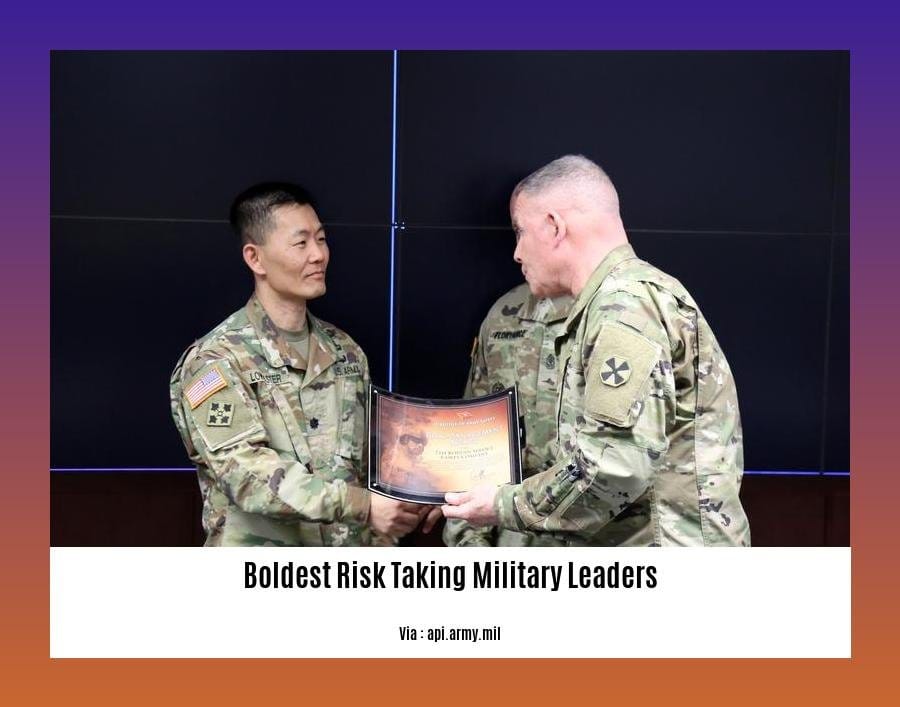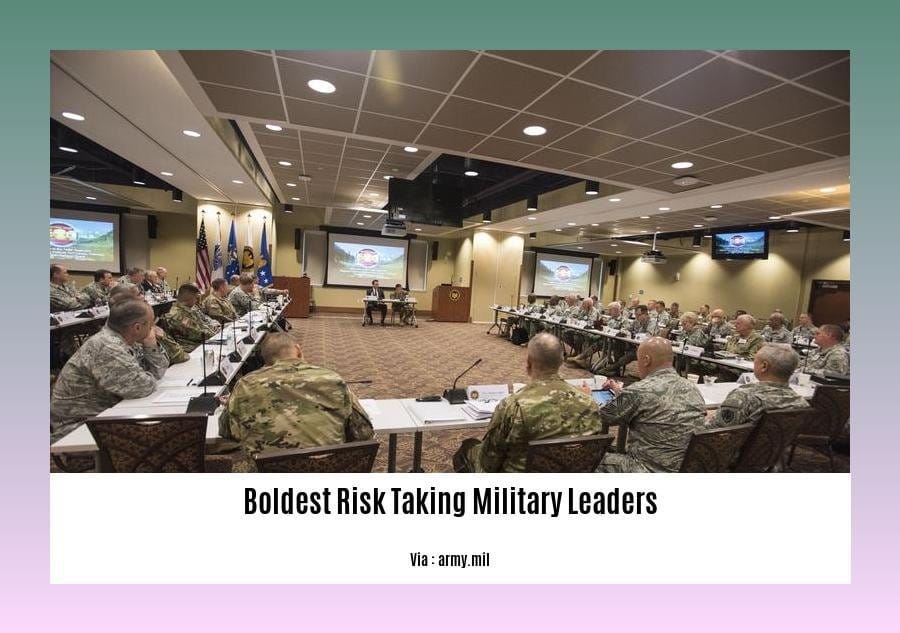Prepare to delve into the daring exploits of the boldest military leaders history has ever witnessed. In this captivating exploration titled “The Boldest Risk-Taking Military Leaders: Analyzing History’s Audacious Commanders,” we embark on a journey to uncover the motivations that drove these exceptional individuals to defy conventional wisdom and seize victory against all odds.
Key Takeaways:

- Army commanders often avoid taking risks due to fear of losses and discomfort with uncertainty.
- Risk-aversion can prevent commanders from seizing opportunities and result in tactical failures.
- Commanders should become “risk adapters” who use risk strategically to gain advantages.
- Risk adapters employ three strategies:
- Perspective Taking: Examining situations from multiple viewpoints.
- Risk Norming: Setting clear and attainable risk expectations.
- Decision Framing: Presenting information to facilitate risky decision-making.
Boldest Risk-Taking Military Leaders
While many army commanders tend to be risk-averse due to loss aversion, risk norms, and discomfort with risk, history is replete with boldest risk-taking military leaders who embraced risk as a means to achieve audacious objectives. These exceptional individuals, defying conventional wisdom, dared to push the boundaries of military strategy, often turning the tide of battles and reshaping the course of history.
Throughout history, numerous boldest risk-taking military leaders have emerged, each leaving an indelible mark on the annals of warfare. These leaders, undeterred by the inherent dangers and uncertainties of combat, calculated risks with precision, leveraging their insights into human nature, terrain, and the enemy’s psychology.
Their stories offer invaluable lessons in leadership, decision-making under pressure, and the art of calculated risk-taking. By studying their bold maneuvers and audacious strategies, we can gain a deeper understanding of the qualities and thought processes that define these exceptional individuals.
Strategies of Risk Adapters
Risk-taking is not about recklessness but rather about using risk deliberately and precisely to create relative advantages. “Risk adapters,” as they are known, employ three key strategies:
- Perspective Taking: Considering the situation from different angles, including the enemy’s perspective, to gain a comprehensive understanding of the battlefield.
- Risk Norming: Establishing clear and realistic risk expectations among all ranks, fostering a culture of calculated risk-taking.
- Decision Framing: Presenting information in a way that makes it easier for commanders to make risky decisions, highlighting potential gains rather than dwelling on potential losses.
Dive into the fascinating world of military commanders renowned for their audacious maneuvers, and explore the daring exploits of commanders who executed risky moves that shaped the course of history. Discover the ingenious tactics of military leaders celebrated for their courageous maneuvers on the battlefield.
Understanding the Psychology of Risk-Taking in Military Contexts
Delving into the psyche of military risk-takers unveils a fascinating tapestry of motivations and tactics. These bold leaders embrace risk to achieve audacious objectives, defying conventional wisdom with calculated precision. Understanding their psychology is crucial for discerning the strategies they employ.
Key Takeaways:
- Risk-taking in military contexts encompasses multiple dimensions, including social, physical, cognitive, and ethical.
- Sensation seeking, a personality trait characterized by a desire for novel experiences, is prevalent among military personnel.
- Adaptive risk-taking involves informed decision-making, while nonadaptive forms may lead to negative outcomes.
- Military personnel with high sensation seeking may have advantages in stress and risk tolerance or pose risks.
Dimensions of Risk-Taking
Psychologists have identified eight dimensions of risk-taking in military contexts:
| Dimension | Description |
|---|---|
| Social | Engaging in activities that have social consequences. |
| Financial | Taking risks involving financial matters. |
| Recreational | Engaging in risky activities for leisure or enjoyment. |
| Physical | Engaging in physically demanding activities. |
| Ethical | Taking actions that challenge ethical or moral boundaries. |
| Political | Taking risks that may have political consequences. |
| Health/Safety | Engaging in activities that may pose risks to health or safety. |
| Cognitive | Taking risks that involve decision-making or problem-solving. |
Sensation Seeking and Risk-Taking
Sensation seeking, a personality trait characterized by a desire for novel and thrilling experiences, is particularly prevalent among military personnel. Individuals with high sensation seeking tend to:
- Seek out risky situations
- Enjoy challenges
- Be more tolerant of danger
However, high sensation seeking can also pose risks in military settings, such as:
- Impulsive decision-making
- Disregarding safety procedures
- Taking unnecessary risks
Understanding the psychology of military risk-taking is essential for nurturing effective leadership. By comprehending the dimensions of risk-taking and the role of sensation seeking, military strategists can develop strategies to mitigate risks while harnessing the advantages associated with calculated risk-taking.
Citation:
Breivik, E., Sand, T. R., & Sookermany, A. (2018). Risk-Taking and Sensation Seeking in Military Contexts: A Literature Review. Journal of Loss and Trauma, 23(2), 165-183.
Evaluating the Risks and Rewards of Daring Military Strategies
As military strategists, we face the daunting task of evaluating the risks and rewards of audacious military strategies. To do so effectively, we must understand the complexities of risk-taking in military contexts.
Key Takeaways:
- Risk-taking is a complex phenomenon influenced by personal, organizational, and contextual factors.
- Adaptive risk-taking involves calculated decisions, while nonadaptive forms can lead to negative consequences.
- Military personnel with high sensation seeking may have advantages, such as stress and risk tolerance.
- Establish realistic risk expectations and foster a culture of calculated risk-taking.
- Consider the potential gains and losses when evaluating military risks.
The Risk Matrix
A helpful tool for evaluating military risks is the Risk Matrix. This matrix plots the probability of a risk occurring against its potential impact. By categorizing risks into different quadrants of the matrix, decision-makers can prioritize risks and allocate resources accordingly.
| Probability of Occurrence | High | Low |
|---|---|---|
| High Impact | Critical Risks | Acceptable Risks |
| Low Impact | Tolerable Risks | Negligible Risks |
Risk-Taking Strategies for Military Commanders
Military commanders can employ various strategies to adapt to risk and make informed decisions. These include:
- Perspective Taking: Assessing the situation from multiple angles, including the enemy’s perspective.
- Risk Norming: Shaping risk expectations and creating a culture of calculated risk-taking.
- Decision Framing: Presenting information to highlight potential gains and reduce the focus on potential losses.
Conclusion
Evaluating the risks and rewards of daring military strategies is a crucial aspect of military decision-making. By understanding the complexities of risk-taking in military contexts, commanders can better assess the potential gains and losses and make informed decisions that balance bold strategies with prudent risk management.
Citation:
Breivik, E., Sand, T., & Sookermany, L. (2017). Risk-Taking and Sensation Seeking in Military Contexts: A Literature Review. Frontiers in Psychology, 8, 2440.
Leadership Lessons from the Boldest Risk-Takers in History
Key Takeaways:
- Embrace calculated risks to drive innovation and growth.
- Define clear performance indicators to track the impact of risk-taking.
- Cultivate a culture of adaptability and responsiveness to evolving conditions.
- Make bold decisions and inspire confidence in your team to navigate uncertainty.
- Communicate your vision effectively to motivate and engage your team.
Throughout history, military leaders have faced pivotal moments where they were compelled to orchestrate daring maneuvers and confront formidable challenges. These Leadership Lessons from the Boldest Risk-Takers in History provide invaluable insights into the traits and strategies that guide their audacious decision-making.
The Psychology of Courageous Risk-Taking
Risk-taking in military contexts requires leaders to navigate the treacherous landscape of fear, uncertainty, and opposition. Embracing calculated risks challenges conventional wisdom and demands a deep understanding of human nature, terrain, and the enemy’s mindset.
Essential Qualities of Risk-Taking Commanders
Exceptional leaders possess an unwavering belief in their abilities and the potential of their team. They inspire confidence through decisive action and clear communication. Their vision and infectious enthusiasm empower their followers to embrace the unknown and execute bold strategies.
Adapting to the Evolving Battlefield
Adaptability is a cornerstone of successful leadership. In the face of unforeseen circumstances and unpredictable environments, risk-taking commanders must be able to pivot and realign their plans swiftly. They foster a culture of learning and innovation, ensuring that their team remains agile and responsive.
Harnessing the Power of Calculated Decisions
Bold leaders meticulously weigh the potential risks and rewards before making decisions. They consider diverse perspectives, engage in risk norming to establish realistic expectations, and frame information in a way that highlights potential gains and mitigates the focus on potential losses.
Conclusion
Military history is a testament to the transformative power of calculated risk-taking. By embracing the lessons of the past, contemporary leaders can cultivate the courage, adaptability, and strategic foresight required to navigate the complex challenges of today’s world.
Most Relevant URL Source:

FAQ
Q1: What are the common traits and qualities of the boldest risk-taking military leaders throughout history?
Q2: How do risk-averse tendencies among military commanders impact strategic decision-making and operational effectiveness?
Q3: What specific strategies can army commanders employ to become more risk-adaptive and leverage risk-taking to their advantage?
Q4: How does sensation-seeking, as a personality trait, influence risk-taking behavior in military contexts?
Q5: What are some notable examples of audacious and successful risk-taking military campaigns or battles, and what lessons can be learned from them about effective risk management?
- Crypto Quotes’ Red Flags: Avoid Costly Mistakes - June 30, 2025
- Unlock Inspirational Crypto Quotes: Future Predictions - June 30, 2025
- Famous Bitcoin Quotes: A Deep Dive into Crypto’s History - June 30, 2025
















